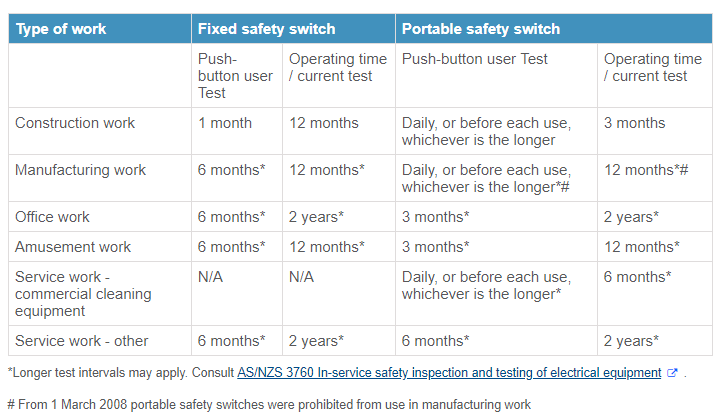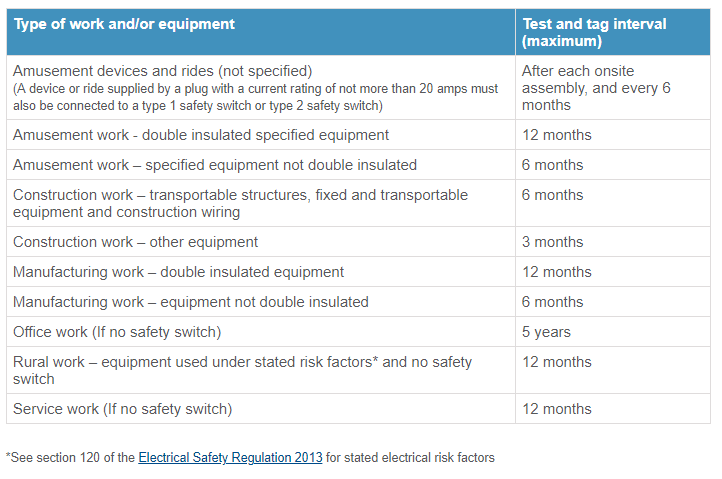Everything you need to know about testing and tagging!
What is testing and tagging?
Testing and tagging is an electrical service provided to ensure your electrical appliances are safe to use. There are two components to testing and tagging; first, we visually inspect the equipment for defects, damage, and missing components. Second, we provide electrical tests measuring insulation resistance, polarity, and earth continuity. Equipment is then tagged (labelled) with the appropriate safety status.
We help you:
- Identify potential electrical hazards, this includes malfunctioning equipment.
- Stay up-to-date with your safety plans, without the hassle. We organise the schedules, and it’s left in our capable and experienced hands.
- Management replacements efficiently, no hassle, we make the process seamless and easy.
- Ensure personal and equipment safety to you and your workplace
- All of your testing requirements, knowing they are completed by licensed, qualified professionals.
- Manage current certificates of conformity and registration if required.
We test:
- Visually inspecting all relevant electrical items
- Insulation resistance
- Earth leakages
- Lead connections and polarity
- Earth resistances and earth bonds
- Ensure all equipment is in a safe environment
Testing and tagging is completed under the Australian Standard AS/NZS 3760: 2010 In-Service Safety Inspection and Testing of Electrical Equipment.
Testing and tagging ensures the electrical aspect of your equipment is satisfactory, it does not, however, indicate that your item is operating to manufacturer specifications.
Why do I need to test and tag my equipment?
Under Queensland legislation, if you’re an employer, you must comply with workplace health and safety guidelines. This means ensuring all of your electrical equipment is in a safe working condition. Unfortunately, electrical equipment can wear and tear with time. Testing and Tagging is part of systemic safety planning for your business.
Testing and tagging on a regular basis ensures workplace electrical compliance with Workplace Health and Safety legislation. This substantiates your duty of care.
If you do not comply with the electrical specification, you risk your company being found negligible and liable completely for a workplace accident. Your insurance may refuse your claim or potentially cancel your account. This may influence future insurers covering your company or incur increased account coverage expenses. Your company may also be fined, penalised or if the accident was severe, face possible Imprisonment.
What equipment requires testing and tagging?
All electrical portable and plug-in appliances located within your workplace and up to 2.5m from the ground require regular inspection, testing, and tagging. As a general guide, the following items are required for testing and tagging:
- Laptop Computers
- Desktop computers and monitors
- Printers
- Photocopiers
- Fax machines / telephones / mobile phones / chargers
- Staff kitchen & tea room appliances (dishwashers, kettles, toasters, microwaves, etc.)
- All electric power tools
- Extension cords
- Power boards
- Leads / cord sets
- All double insulated appliances
- Audio/visual equipment (speakers, projectors, auditorium appliances)
- Portable air conditioners
- Isolation transformers
- Desk lamps
- Vacuum cleaners and electrical cleaning equipment
- Forklift chargers
- 3 phase electrical equipment
- RCD’s (Safety Switch)
Items will be classed as either:
- Class I – earthed appliances e.g. kettles and toasters.
- Class II – double insulated appliances identified with a symbol e.g. electrical tools or hairdryers.
What areas require testing and tagging?
The entirety of your work place must be tested and tagged; this includes:
- All office areas
- Factory
- Laboratory
- Workshops / tool rooms
- Kitchens, dining areas and lunch rooms
- Waiting and lounging areas
- Bathrooms and showers
- Spa and pools
- Classrooms / training rooms / meeting rooms
- Construction areas
- Temporary locations
- Car parks
- Manufacturing areas
- Retail sales areas
- Walkways / Hallways if necessary
Testing and tagging requirements of hire equipment / new purchases
Electrical hire equipment defined as level 3 must have current conformity certification and registration on the national database. Upon purchasing electrical equipment, in-scope electrical equipment must meet the QLD requirements and standards, confirmed safe by a licensed and qualified electrician/supplier prior to purchasing.
Unsafe electrical equipment will be prohibited for use and issued notices by the Electrical Safety Office.
How often do I need to test and tag my equipment?
Under the AS/NZS 3760 legislation, there are minimum time requirements for testing and tagging your equipment. Please see below tables of QLD Work Safe recommended timeframes. For further information specified electrical equipment, review section 97 of the Electrical Safety Regulation 2013.


Table sources – Worksafe Queensland Maximum test and tag intervals
How much testing and tagging cost?
Testing and tagging is priced at an hourly rate. The quote will depend on how many items require testing and tagging. Contact our team to find out more about pricing here.
What to expect from Taylor Made Electrical testing and tagging service?
We are a team of experts with valuable knowledge, and ensure you are kept up-to-date with legislation. We’ll provide excellent communication and explanations of the testing and tagging procedure. You’ll be provided with:
- A qualified, insured and knowledgeable electrician to attend your company premises
- WHS and electrical safety legislation information and resources.
- Your safety obligations as per the QLD standards and how to achieve safety goals easily.
- Adequately answer all of your electrical safety questions.
- Discuss and provide you with your workplace testing and tagging timeframes.
- Complete comprehensive, well-performed testing and tagging.
- Schedule re-testing convenient for your company.
- Provide you with a detailed electronic report in compliance with the QLD government safety guidelines
What happens if items fail the testing and tagging?
If items fail testing and tagging, they will be tagged with “DANGER” or “OUT OF SERVICE”.
If your items have failed testing, they can be repaired or replaced prior to workplace reintroduction. Do not use the equipment. Remove failed equipment from the workplace immediately. Failed equipment is highly dangerous and proves hazardous to your workplace. We will help you establish what is the best option for your equipment for workplace reintroduction.
Do I need to test brand new equipment?
If your equipment is store bought brand-new and NOT second-hand, it can be tagged as “New To Service”, ready for testing at the next inspection. It is important to remember that new items are still susceptible to non-compliance and faulty wiring/earthing and may be electrically unsafe due to poor quality. It is highly recommended to test and tag new equipment for company peace of mind.
Do I need to test second hand equipment?
Yes, you must test and tag second-hand equipment.
If I own a business, do I need to test and tag my employees' personal equipment e.g. mobile phones/charging or tooling?
If an employee their own equipment for company work execution or on your premises, equipment should be tested to avoid company liability.
What is an RCD and does it need testing?
RCD (Residual Current Device) is a safety switch also known as ELCB’s (Earth Leakage Circuit Breakers). It is designed to ‘trip’; stopping power to faulty electrical equipment and avoid dangerous electrical shock situations. The RCD requires testing under section 165 of the Work Health and Safety Regulation 2011 to ensure ‘trip times’ are effective. Faults with RCDs can be deadly and lead to fatal electrocution, it is absolutely vital to ensure your RCD is compliant.
Portable RCDS must also be tested and tagged.
If your company does not have an RCD electrical circuits are not protected if a fault occurs. It is highly recommended to comply with safety legislation, that you have a comprehensive inspection and installation of RCDs in all relevant workplace areas.
Do I need to turn equipment off during the testing and tagging procedure?
All items must be removed from power and unplugged; this will be for a short duration. For RCD testing, the entire switchboard must be removed from power while testing is completed.
How long will testing and tagging take?
This is dependent upon your business requirements. The more equipment, the longer the process. An estimate guide is 10 – 20 appliances within an hour. Staff will be required to shut-down their computers for an estimate of 3 – 5 minutes each for the testing procedure. Please ensure that equipment requiring testing is easily accessed, and if required, briefly move obstructive furniture or equipment to avoid delays.
How will I receive the tagging and testing inspection report?
A PDF comprehensive report will be sent to your provided email address within 48 hours. If you require it urgently, please let us know.
What is on my testing and tagging records and do I need to keep my testing and tagging records?
The legislation requires testing and tagging records to be kept for a minimum of 7 years or for the life duration of the equipment (whichever is greater). If you lose your report, you can re-order from the electrician who completed the test and tag.
Who performs testing and tagging?
Testing and tagging must be performed by licensed, qualified and insured electricians.